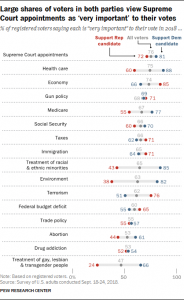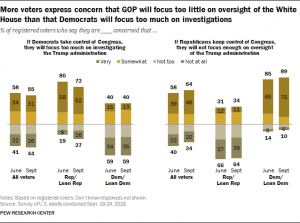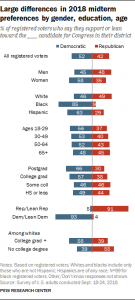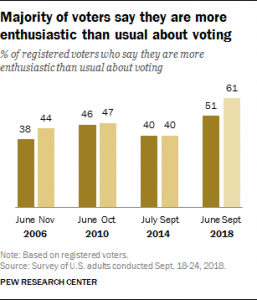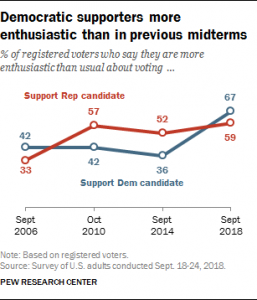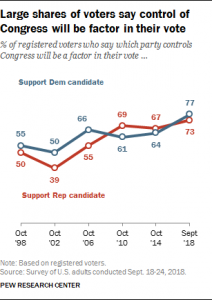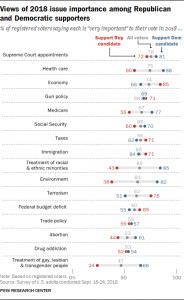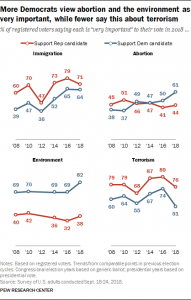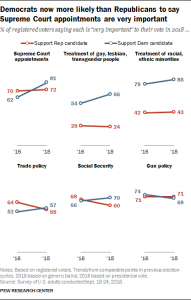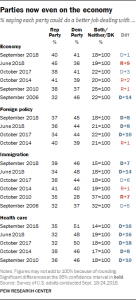Photo by University of Central Florida Libraries, Creative Commons
Top voting issues: Supreme Court, health care, economy.
Pew Research / 09.26.2018
With less than six weeks to go before the elections for Congress, voter enthusiasm is at its highest level during any midterm in more than two decades. And a record share of registered voters – 72% – say the issue of which party controls Congress will be a factor in their vote.
Opinions about Donald Trump also continue to be an important consideration for voters. A 60% majority views their midterm vote as an expression of opposition or support toward Trump – with far more saying their midterm vote will be “against” Trump (37%) than “for” him (23%).
The new national survey by Pew Research Center, conducted among 1,754 adults, including 1,439 registered voters, finds that the Democrats have several advantages at this point in the campaign.
First, Democrats hold a 10-percentage point lead over the Republicans in the generic ballot. About half of registered voters (52%) say if the election were today, they would vote for the Democrat in their district or lean toward the Democratic candidate; 42% say they would support the Republican or lean Republican. In June, the Democrats’ lead in the generic ballot was five percentage points (48% Democratic, 43% Republican).
Second, while voter enthusiasm is relatively high among voters in both parties, it is somewhat higher among voters who favor the Democratic over the Republican candidate. Overall, 61% of all registered voters say they are more enthusiastic about voting than in past congressional elections, higher than at any point during midterms in the past two decades, including at later points in those elections.
Two-thirds of Democratic voters (67%) say they are more enthusiastic than usual about voting, compared with 59% of Republican voters. The share of Democratic voters who express greater enthusiasm about voting is substantially higher than at comparable points in three prior midterms, while enthusiasm among GOP voters is slightly higher than in September 2014 (52%) and about the same level as in October 2010 (57%).
Third, more Americans view the Democratic Party than the Republican Party as more concerned with people’s needs, more honest and ethical and more willing to work with leaders from the other party.
In the past, the Democratic Party has often held advantages on these traits, but in January 2017, shortly before Trump’s inauguration, the GOP ran nearly even with the Democrats on honesty and ethics and concern for “people like me.”
As in the past, neither party has an edge on better managing the government (43% say the Democratic Party, 40% the Republican Party). More people continue to regard the Republican than the Democratic Party as “more extreme in its positions” (48% Republican Party, 39% Democratic Party).
In terms of issues, the Democratic Party continues to hold a wide advantage over the Republican Party on dealing with health care (51% to 35%) and modest leads on foreign policy and immigration. While the two parties run about even on dealing with the economy (41% Democratic Party, 40% Republican Party), that represents a change since June, when the GOP held a significant, 9-point edge on handling the economy.
Top issues for voters: Supreme Court, health care, economy
The survey, conducted amid allegations of sexual misconduct by Brett Kavanaugh, Trump’s nominee for the Supreme Court, finds that large majorities of voters in both parties view Supreme Court appointments as a “very important” voting issue.
Overall, 76% of registered voters – including 81% who support the Democratic candidate and 72% who favor the Republican candidate – say appointments to the court will be very important to their vote this fall.
Among all voters, Supreme Court appointments rank with health care (75%) and the economy (74%) among the top voting issues.
While health care and the economy typically rank among the top issues for voters, there is no trend to past midterms on the importance of court appointments.
However, more voters view Supreme Court appointments as a very important issue today than did so in June 2016, during the presidential election. At that time, 65% of voters (70% of Republicans and 62% of Democrats) said court appointments were very important.
There are sizable partisan gaps over the importance of a number issues. As in the past, Democratic voters (82%) are far more likely than Republicans (38%) to say the environment will be very important.
The gap is about as large over the importance of the treatment of racial and ethnic minorities and the treatment of gay, lesbian and transgender people. Democratic voters are about twice as likely as Republican voters to consider the treatment of racial and ethnic minorities as a very important voting issue (85% vs. 43%). And while two-thirds of Democrats (66%) view the treatment of gay, lesbian and transgender people as very important, just 24% of Republicans do so – the lowest share of Republicans citing any of the 16 issues as very important.
Democrats also are more likely than Republicans to view health care, Medicare and abortion as very important voting issues. More Republicans than Democrats rate the economy, terrorism, the federal budget deficit and taxes as very important.
Comparable shares of voters in both parties rate several issues as very important. For example, 71% of voters who favor the Republican candidate in their district and 69% who support the Democrat say gun policy will be very important. There also are not significant partisan differences on the importance of drug addiction and trade policy.
Looking ahead: Concerns about too little – or too much – oversight of the Trump administration
Voters remain concerned that no matter which party prevails in the midterms, they will not strike the right balance in overseeing the Trump administration. But unlike three months ago, more voters are concerned about what the GOP may fail to do if they retain control of Congress than what the Democrats might do if they gain control of Congress.
Currently, 64% of voters say if the Republicans keep control of Congress, they are very or somewhat concerned that the GOP will not focus enough on oversight of the administration. A smaller majority (55%) expresses concern that if the Democrats take control of Congress, they will focus too much on investigating the Trump administration. In June, identical shares of voters (58% each) had concerns over both possible scenarios.
These opinions remain deeply divided along partisan lines, but Democrats are increasingly likely to express a great deal of concern that, if Republicans prevail, they will fail to do enough oversight of the Trump administration. Three-quarters of Democratic voters say they are very concerned about this, up from 65% three months ago.
By contrast, only about half of Republican voters (52%) say they are very concerned that if Democrats win control of Congress, they will focus too much on investigating the Trump administration. That is lower than the share of Republican voters (58%) expressing a high level of concern over Democratic overreach in June.
Democrats Have 2018 Edge in Voting Preferences
With less than 50 days until the 2018 congressional elections, Democrats hold a 10-percentage-point advantage over Republicans on the generic ballot among all registered voters.
Today, 52% of registered voters say they support or lean toward the Democratic candidate for Congress in their district, while 42% say they prefer the Republican candidate.
The share of voters who say they support or lean toward the Democratic candidate is slightly higher than it was in June (48% then, 52% today), while the share who back GOP candidates is little changed (43% then, 42% now).
Today, as in earlier surveys, there are wide differences in voting preferences by gender, race, education and age.
Democratic candidates have a 23-point edge over Republican candidates among women voters (58% to 35%). By contrast, men are roughly evenly divided in their preferences: 48% of men support the GOP candidate, 45% say they prefer the Democratic candidate.
White voters are about evenly divided in their preferences (46% favor the Democratic candidate, 49% favor the Republican candidate), while black voters overwhelmingly back Democrats. Hispanic voters continue to favor Democratic candidates by about two-to-one (63% to 29%).
While those ages 50 and older are split in their choice of candidate, Democrats have a significant edge among younger voters.
Education is also associated with voter preferences: Those with a college degree or more favor Democratic candidates by a wide margin (59% to 36%), while those with no college degree are roughly evenly split (45% favor the GOP candidate in their district, while 48% favor the Democratic candidate.)
Voters express record high levels of enthusiasm for a midterm
As the election approaches, a growing share of voters say they are “more enthusiastic than usual about voting” – and the share expressing this is now substantially higher than in any midterm election since the question was first asked two decades ago.
In June, 51% of registered voters said they were more enthusiastic than usual. Three months later, 61% say this, which is 14 points higher than the prior high for this measure (47% in October 2010).
Today, only 22% of voters say they are less enthusiastic about voting than usual – no fewer than three-in-ten said this in prior midterms – while 14% volunteer that they feel about as enthused as in previous congressional elections.
Among those who support Democratic candidates, reported levels of enthusiasm are much higher than in past midterm years: Two-thirds (67%) say they are more enthusiastic than usual; by contrast, fewer than half said this in midterms dating back to 2006. Among GOP voters, 59% say they are more enthusiastic than usual about voting – on par with the share saying this in October 2010 and modestly higher than in 2014.
The share of voters saying they are following news about candidates and election campaigns very or somewhat closely has increased substantially from June. Today, about seven-in-ten voters (72%) say they are following election news at least somewhat closely compared with about six-in-ten (59%) in June.
This increase in attention is most pronounced among those who say they are supporting the Democratic candidate in their district. In June, supporters of Republicans and Democrats were about equally likely to say that they were following election news very closely (24% of Republican voters and 23% of Democratic voters), but today Democratic voters are more likely than Republican voters to be following election news very closely (30% of Republican voters compared with 36% of Democratic voters).
For most voters, Trump looms large in their congressional vote
Overall, six-in-ten voters (60%) say that Trump will factor into their vote for Congress this fall. This is larger than the share of voters who said Barack Obama would factor into their 2014 congressional vote choice, but similar to the percentage who named Obama in 2010 or George W. Bush in 2006 at similar points in those election years.
More than a third of voters (37%) say they consider their congressional ballot as a vote against Trump, while about a quarter (23%) say they consider it a vote for Trump.
About two-thirds (66%) of Democratic and Democratic-leaning voters say they think of their vote for Congress as a vote against Trump, while about half (48%) of Republican and Republican-leaning voters say they think of their vote as a vote for Trump. The share of Republicans and Republican leaners who say their congressional vote is for Trump is higher than the share saying this about Bush in October 2006 but roughly on par with the share of Democrats who considered their 2010 congressional vote as a vote in support of Obama.
The percentage of Democratic voters who consider their vote for Congress as a vote against the president (66%) is comparable to the percentage of Democrats who considered their 2006 vote as a vote against Bush. It is also similar to the share of Republican voters in 2014 who considered their vote for Congress as a vote against Obama.
About seven-in-ten voters (72%) say that which party will be in control of Congress is a factor in their vote in November, the highest share saying this in any election over the past two decades. While the share of Republican supporters who say this is only modestly higher than the share saying this in 2010 and 2014, among Democratic supporters, the share who say party control is a factor in their vote is substantially higher than in any prior midterm election dating back two decades.
Wide partisan differences on importance of many issues
Voters who plan to support Republican or Democratic candidates this November differ over the importance of many issues to their 2018 votes, but one issue that ranks high across the political spectrum is Supreme Court appointments: 81% of Democratic voters and 72% of GOP voters consider this to be very important to their vote this year.
Large majorities of Democratic voters also view health care (88%), the treatment of racial and ethnic minorities (85%) and the environment (82%) as very important voting issues. These issues rank far lower among Republican voters. Six-in-ten Republicans say health care is very important to their vote this year, and only about four-in-ten say the same about the treatment of racial and ethnic minorities (43%) and the environment (38%).
The economy tops the list of important issues in the upcoming election among supporters of GOP candidates, with 85% saying it is very important – a view shared by a smaller majority (66%) of those backing Democratic candidates. And while 76% of GOP voters say terrorism is very important to their 2018 vote, just 51% of Democratic voters say the same.
Republican voters are somewhat more likely than Democrats to name taxes (71% vs. 62%), immigration (71% vs. 62%) and the federal deficit (65% vs. 55%) as very important to their vote. And Democratic supporters are more likely than Republican backers to name the treatment of gay, lesbian and transgender people (66% vs. 24%), Medicare (77% vs. 55%), abortion (61% vs. 44%) and Social Security (70% vs. 60%) as very important.
Health care is a more important issue to Democratic voters this year than in 2016 or 2014, while its importance has fallen among voters supporting Republicans. Before the 2014 midterm elections, there was a 5-percentage-point gap between Republican and Democratic voters; this fall the gap is 28 points.
Democratic voters are less likely to rate the economy as a very important voting issue than in past years. Currently, 66% say the economy is very important, the lowest share saying this in a decade. Republican voters continue to rank the economy as a top voting issue (85% very important).
The federal budget deficit has been more important to Republicans than to Democrats since 2010, but the share of Republicans saying this is down by double digits (65% say this today, down from 81% in 2014 and 82% in 2012). Among voters in both parties, the importance of taxes is little changed from 2012.
Over much of the last decade, Republican voters have been more likely than Democratic voters to say immigration is a very important issue in their vote. But the gap is narrower than in the past. Today, the gap between Republicans and Democrats is just seven points (71% to 64%).
About six-in-ten (61%) supporters of Democratic candidates now say they consider abortion to be a very important issue to their vote; this is the first time in the past decade a majority of Democratic voters have said this. The share of Democratic voters who rate abortion as very important has increased 14 percentage points since 2014 and 23 points since 2008. Republicans are about as likely today as in the past to say abortion is very important to their vote.
Supporters of Democratic candidates have consistently been more likely than GOP backers to consider the environment to be very important to their vote choice, but the share of Democratic voters saying this has increased from past years. About eight-in-ten (82%) now say this is very important, up from 69% in both the 2016 and 2014 elections. There is little change in the importance of this issue among Republican supporters.
While several issues have become more important priorities for Democratic voters, terrorism has fallen sharply in importance. About half of Democratic voters say terrorism will be very important, down 23 percentage points from 2016. The partisan gap over the importance of terrorism, which has been evident for a decade, now stands at 25 points (76% of Republicans, 51% of Democrats).
As Congress considers Brett Kavanaugh’s nomination to the Supreme Court, appointments to the high court rank among the top issues for both Democratic and Republican voters this year. But, in contrast to 2016, Democratic voters are now more likely than Republican voters to say this is very important to their vote. The share saying this among Republican voters is largely unchanged from 2016 (about seven-in-ten both years), but the share of Democrats saying the court is very important for their vote is 19 points higher than it was in 2016 (81% now, 62% then).
The share of voters saying the treatment of gay, lesbian and transgender people is very important is up this fall among Democratic supporters (66% now from 54% in 2016) but little changed among Republican backers (24% now; 25% in 2016).
The pattern since 2016 is similar for the importance of the treatment of racial and ethnic minorities. Currently, about twice as many Democrats (85%) as Republicans (43%) rate this issue as very important.
Public now divided over which party could better handle the economy
As the midterms approach, the two parties run about even on the issue of the economy, while the Democratic Party holds a wide advantage on health care and modest leads on foreign policy and immigration.
Overall, 41% of the public says they think the Democratic Party could do a better job dealing with the economy; about as many (40%) say the Republican Party could do the better job.
The Democratic Party holds a narrow 7-point edge over the Republican Party as the party seen as better able to handle the issue of immigration (46%-39%) and a similar 8-point advantage (45%-37%) on which party could better handle foreign policy.
The Democratic Party holds a sizable advantage on health care: 51% say the Democratic Party could do the better job on this issue compared with just 35% who name the Republican Party.
The two parties currently run even on the economy (40% say the Republican Party could do a better job, 41% say the Democratic Party). This represents a shift from three months ago, when more said the GOP (45%) than the Democratic Party (36%) could do the better job on the economy.
At the same time, the Democratic Party’s edge on the issue of immigration has narrowed since the summer. In June, the Democratic Party was favored by 14 points on this issue, compared with a 7-point edge today.
Public views on which party could better handle foreign policy and health care are little changed over the last year.
Democratic Party favorability rises ahead of midterms
The public now holds a more favorable view of the Democratic than Republican Party – marking a shift from earlier this year when the two parties were rated about the same.
Overall, 53% have a favorable view of the Democratic Party compared with 42% who have an unfavorable view. Favorable ratings are up 11 points from 42% in March.
By contrast, more hold an unfavorable (52%) than favorable (43%) view of the Republican Party. GOP ratings are about the same as they were in the spring. Over the past 10 years, the Democratic Party has often held a favorability advantage over the GOP, with last spring being one of several exceptions.
Among independents who lean Democratic, ratings of the Democratic Party have rebounded from recent years. In March, just 53% of Democratic leaners said they had a favorable view of the party, 81% now say this. Ratings among Democrats have seen a more modest movement in the positive direction (82% favorable in March; 92% favorable today).
Originally published by Pew Research Center, reprinted with permission for non-commercial, educational purposes.




